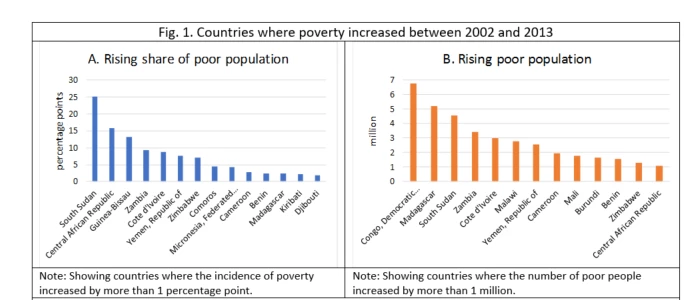The last quarter century saw remarkable progress against extreme poverty, globally. Between 1990 and 2013, the percentage of the world’s population living at or under $1.90/day fell from 35.3% to 10.7% - that is, from more than one in three people to approximately one in ten, planet-wide. Even in the shorter period between 2002 and 2013, the reduction was from 25.8% to 10.7%, meaning that about 850 million people moved out of extreme poverty during that decade alone.
Yet, progress has been far from even. In previous analysis, we have often focused on differences in regional performances, highlighting the gap between progress in East Asia and Africa, for example. Here, we look more granularly at the country level, and highlight the plight of countries where, despite the general declining trend, poverty has actually increased between 2002 and 2013 – either in terms of the extreme poverty rate, or of the absolute numbers of people living under $1.90/day.
If we look at the 152 countries for which we have extreme poverty estimates in 2002 and 2013, the incidence of extreme poverty (with respect to the international poverty line of $1.90/person per day) fell in 116 countries, and rose or remained the same in 36 countries. To allow for sampling variability and other sources of comparison problems, let us consider only the 14 countries where the poverty headcount rose by more than 1 percentage point during 2002-2013: Their poverty changes are shown in Panel A of Figure 1 below.
Poverty can also be assessed in terms of the absolute number of poor people, and population growth means that the number of extremely poor people in a country can rise even when the percentage of the population living in extreme poverty is falling. For the same 152 countries, the number of poor people rose or remained the same in 53 countries. The 13 countries where numbers rose by more than 1 million (which together account for 87% of the total increase in the number of poor in those 53 countries) are shown in Panel B of Figure 1.
With the exception of Yemen (both panels), and Djibouti, Kiribati and Micronesia (Fig. 1A), all countries included in Figure 1 are in Sub-Saharan Africa. Fragility and conflict are clearly important factors contributing to rising poverty. For example, in South Sudan, extreme poverty increased by 25 percentage points (from 44 to 69 percent of the national population) or by 4.6 million people between 2002 and 2013. The Central African Republic (both panels), and the Democratic Republic of the Congo and Burundi (Fig. 1B) are also fragile states that have experienced substantial conflict and violence over the period. In a study of comparable, high-quality African surveys between 1996 and 2012, fragile countries had systematically slower poverty reduction.
Other countries where poverty increased experienced economic mismanagement (Zimbabwe) or political crisis (Guinea-Bissau and Madagascar). In yet other cases, such as Cameroon or Zambia, conflict and war were not a factor, but economic growth has been excessively dependent on a capital-intensive natural resource sector, to the detriment of the bulk of the population who remain insulated from the booming enclave, and work primarily in subsistence agriculture.
Source: PovcalNet. Poverty is measured using the international poverty line of $1.90/person per day. When countries do not have surveys in 2002 or 2013, interpolation and extrapolation methods are used.
When looking at the absolute number of poor people, rapid population growth is another important factor. Consider Mali (Fig. 1B), a country that has seen reasonable growth in GDP over this period, and where the poverty rate declined by 6 percentage points (from 58% to 52%), but where the total population grew very rapidly (by 42% between 2002 and 2013). The result was that the total number of poor people increased by 1.8 million. The Democratic Republic of the Congo (Fig. 1B) is another example of a country with fast population growth.
In conclusion, the world’s recent successes against extreme poverty are no cause for complacency. It is not only that leaving anyone behind, subsisting on less than $1.90 a day, is unacceptable. It is also the case that there are a number of countries where the scourge of poverty has actually been on the rise, even during the relatively good times of 2002-2013. A full 262 million people live in the countries in Figure 1B (using 2013 numbers).
There is no room in this short blog to dwell upon the factors associated with successes in poverty reduction – which, as the numbers above indicate, were far more common over this period. Each successful country has its own unique story, but World Bank (2016) discusses some common elements they tend to share. These include prudent macroeconomic policies, broad-based growth, well-functioning labor markets, coherent safety net systems, and sustained investments in both human capital and infrastructure. For the world community as a whole, and the World Bank in particular, a key priority is to help the countries that are being left behind by global progress to address the specific issues holding them back – frequently fragility and conflict – and join the larger group of nations successfully reducing extreme poverty.





Join the Conversation